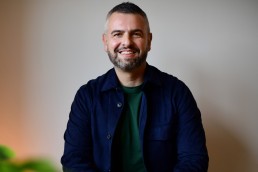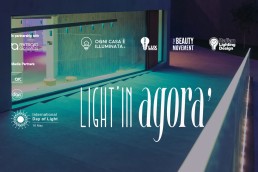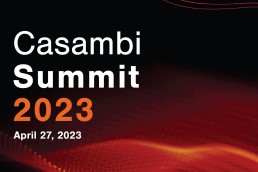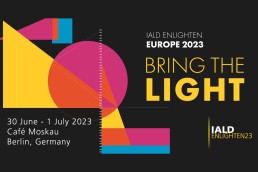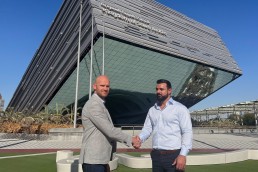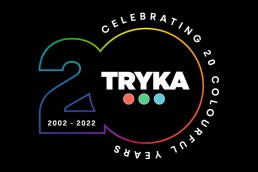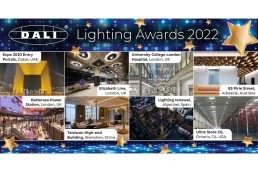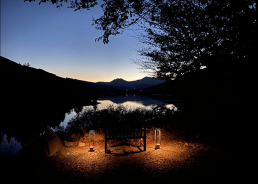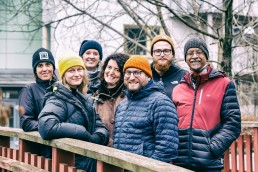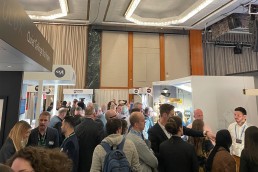Battersea Power Station, UK
One of the largest, most prestigious redevelopment projects in recent years, London’s iconic Battersea Power Station finally reopened to the public in late 2022.
Already a landmark in the city’s skyline, after nearly a decade-long process, the revived building incorporates retail, hospitality, commercial and residential spaces, and has instantly become a must-see destination for tourists and locals alike. The lighting design for this monumental project was led by Speirs Major.
Speirs Major first joined the project in 2014, developing a lighting masterplan that created the long-term vision and guidelines, not only for the illumination of the Power Station and its associated public spaces, but also for the entire mixed-use scheme, which is being delivered in multiple phases over several years.
Anchored by a spectacular after-dark image that celebrates both the industrial heritage of the site, as well as its exciting new future, the lighting masterplan looked to “guide the use of light in support of a positive experience of the development for all its different users”, delivering a sense of privacy and intimacy for residents, facilitating easy wayfinding for shoppers and diners, and creating a vibrant atmosphere for locals and tourists alike.
To achieve this delicate balance, the lighting masterplan blends light and darkness across the site, with adjustments in both the quantity and quality of light according to patterns of use and the time of the day.
At a holistic level, the light intensities and the scale of the equipment have been choreographed to allow the architecture and landscape to have prominence. Lighting levels tail off adjacent to the Power Station and the Thames, preserving views and providing an appropriate setting for the building.
At the point that Speirs Major joined the project, the lighting for Phase 1 of the public realm had already been designed by Equation Lighting Design. This related only to the public realm associated with the first new apartment building to be built, not the Power Station itself. Speirs Major reviewed the Phase 1 design, aligning it with the overall masterplan.
With regards to the wider public realm lighting, the intent was to “reflect on the industrial heritage” with a consistent, warm golden tone across the whole site. Therefore, soft lighting to routes, pathways and landscape creates a welcoming character while meeting functional safety and security requirements. Overall light levels are generally kept minimal to help manage energy use and help reduce environmental impact, but increased at meeting places, gateways, and corners to improve legibility and encourage social interaction.
Inside the building, the vast complex of spaces are broken down into a number of different areas, each with their own unique identity and character – these include the main retail environments within the old Turbine Halls and Boiler Houses; heritage spaces in the former Control Rooms; and residential lobbies and roof terraces, situated in the Switch Houses and Wash Tower lobbies.
Mark Major, Senior Partner at Speirs Major, explained how the team managed the complexity of the project: “Setting aside the preserved historic spaces (Control Rooms, Director’s Entrance, etc), there is a commonality across most of the other interior spaces, in the sense that they have been refurbished as functioning spaces with a contemporary industrial aesthetic. So, the designs focus on simple, bold details that pick up on the character of those spaces, helping to create a vibrant background setting for the retail and leisure activities.”
Clementine Fletcher-Smith, Partner at Speirs Major, added: “With such a large and complex project, we worked to keep our designs simple and effective by focusing on key, bold moves, rather than lots of complicated details. Nevertheless, due to the massive underlying complexities in geometry and heritage restrictions, we required many individual lighting details for each space.”
One of the core ambitions for the lighting design was to achieve a careful balance between maintaining the raw energy of the original spaces, while celebrating their new role within the Battersea development. As a result, in each space, the lighting contributes a vibrant atmosphere that allows the renewed focus on retail and hospitality to figure prominently, while gently celebrating the distinctive heritage and architecture.
In the retail areas, the designers looked to keep the palette of equipment relatively simple and minimal, applying light in different ways to support the unique character of each space. Functional light is predominantly kept local to the level it is illuminating, through a combination of integrated handrail lighting and period-appropriate industrial pendants and bulkheads, with high level downlighting only added where required. “Re-use of certain heritage fixtures found on the site was a fundamental part of the brief, and we worked hard to achieve this where it was feasible and cost-effective,” Fletcher-Smith added. Over this, a layer of elegant architectural accent lighting enhances and reveals the defining details.
Turbine Hall A was part of the original 1930s Power Station, and is a vast, magnificent industrial Art Deco space. Given such a dramatic setting, it was essential for the design team to use restraint to protect the prominence of the retail environment, while still creating an elegant, refined, and welcoming ambience.
Continuing the lighting language established in the public realm spaces, Speirs Major chose a warm light (2700K), bringing to mind the original tungsten lighting of the period for both the functional and architectural lighting. Gentle highlights to the key details include uplighting the industrial gantries, the main soffit and friezes, and vertical accents to the Art Deco columns.
Added in the 1960s, Turbine Hall B, is characterised by the minimal, Modernist aesthetic of the time.
A smooth, curved roof is penetrated with skylights – some real, and some added using light tubes to unify the appearance of the ceiling. Here, Speirs Major softly washed this extensive surface with colour changing light that adjusts during the day in line with the natural daylight cycle. Cool, crisp white tones enhance the Modernist aesthetic during the day, followed by a warmer ‘sunset’ feel taking over into the evening, with the facility for bold, full-colour change after dark for celebrations, promotions, and events.
Additional ambient colour-change floodlighting integrated within the skylights creates a feature that also pops through into the roof gardens for the residents of Switch House East. Accent lighting picks up the window reveals and the linear form of the bridge structures, while escalators are highlighted in a dynamic, integrated solution that can tie in with the colour of the curved roof, while still providing safe access and contributing to the character of the space.
The two further retail spaces can be found in the two Boiler Houses – North and South. Essentially a pair of raw industrial shells, architects Wilkinson Eyre created a series of contemporary entrances, event, and retail spaces. The lighting design plays up the retained industrial character of the spaces, revealing the texture and colour of the authentic red brick walls and timber finishes, while highlighting the structural steelwork of the modern architectural interventions. The darker finishes and exposed brickwork in these spaces provide little interreflection, resulting in a moodier and more contrasting ambience.
“While of course the primary focus was on creating a fantastic ambience and setting to support the new uses of the Power Station, we also need to focus on the restoration and refurbishment of this much-loved, iconic listed industrial building in an urban setting,” added Major. “So, celebrating the architecture and heritage of the site was also a key part of the design.”
This is particularly evident in the dedicated heritage spaces – Control Room A and B, and the Director’s Entrance. The goal here was to “reinstate the lighting in keeping with the original design intent as far as possible, while adding a discreet extra layer of architectural lighting and control, where needed”, to enable the spaces to be used flexibly for events.
The Director’s Entrance is the original access point to the Control Rooms and Boiler House for the Directors of the Power Station, and dates back to the 1930s. It was originally lit with several statement Art Deco fixtures, some of which had been removed from the site. As part of the overall drive to restore and refurbish the site, Speirs Major created replicas of the missing fixtures based on photographs and drawings, and restored and upgraded the interior wall sconces, lanterns, and pendants found on-site with LED technology.
A dramatic, Grade II* listed space built between 1929-31, Control Room A had been entirely artificially lit since WW2, when the original skylights were blacked out. Restoring and refurbishing these structures means that the space is now filled with natural light; the lighting designers added backlighting externally to maintain the illusion after dark. The space’s original Art Deco, lozenge-shaped fixtures have also been reinstated, having been refurbished and upgraded with LED lighting, along with the unique backlit switching control diagrams and buttons, and prismatic wall lanterns along the back route.
Contrasting the Art Deco design of Control Room A, Control Room B dates back to the 1960s, and is an extremely rare – and as such historically highly sensitive – example of a Modernist control room. Again, original lighting has been reinstated here as far as possible, including a central cove that now houses full colour-change LED battens in place of the original fluorescent lamps, uplighting the soffit and providing flexibility to adapt the space for events. Mid-century opaline light boxes have also been restored and upgraded to LED, and in common with the other heritage spaces, additional concealed high-level functional lighting has been added.
“In terms of our general approach to heritage, we adopted and followed the lead from Wilkinson Eyre, who are not afraid to innovate, while respecting the history and context,” said Fletcher-Smith. “They have great experience in this, and having worked with them previously, we have built up a language together. We understand that while you don’t want to lose the character and history of the building, the final outcome needs to be both contemporary and functional.”
This approach is evident in the lobbies for the residential accommodation, which have been reimagined as contemporary spaces that draw on the industrial heritage of the building while delivering the luxury and comfort expected of high-end residential living.
The lighting here aims to create a welcoming ambience while aiding wayfinding, with warm light focused on key vertical surfaces and onto the ceilings. Gentle washes of light help to reveal the textures and colours in the materials, including brick, concrete, mesh and Corten steel, while Art Deco-style fixtures add a decorative accent.
The four Wash Tower lobbies uniquely feature extremely deep voids. For these, Speirs Major designed a series of special bespoke chandeliers. Suspended at a height of 22-metres, their stacked green glass design was inspired by the form of electricity pylon isolators, in a neat reference to the past use of the space in supplying power to large parts of London. Speirs Major’s unique original concept was further developed in collaboration with the manufacturer, Jonathan Coles Studio. The upper Wash Tower lobbies on the 11th floor feature glowing linear wall lights to fit with the dramatic lined interior, creating an intimate space with views up into the internally illuminated chimneys.
The project is topped off with three roof terraces, each with low accent lighting to planting and seating, providing sufficient lighting to paths for safe use in a beautiful manner, creating scattered, decorative shadows. Roof gardens on Turbine Hall A and B are flanked by illuminated brickwork that contributes to the overall image of the building, providing a close view of the strong contrast and texture produced by the close offset uplights. The terrace on Turbine Hall B is also punctuated by an ethereal glow from the skylights that cut through to the Turbine Hall below. Even lower light levels are used on the Boiler House roof garden to ensure that the reflections of the chimneys in the central, lake-like skylight are not compromised.
Perhaps the most defining element of the restoration of Battersea Power Station though, comes with its revived after dark identity. Despite undoubtedly being an icon of the London cityscape by day, the building has previously never been formally illuminated – instead being the subject of many one-off light shows over the years. Now, the building enjoys a sensitive, yet high-impact permanent exterior lighting scheme that stands a potent symbol of its rejuvenation as an innovative mixed-use neighbourhood, while also honouring its industrial heritage. Topped by the illumination of the Station’s four famous chimneys, the exterior lighting highlights key architectural elements, drawing out the materiality of the building and its fine detailing to create an appealing ambience that blends the old with the new.
Taking into account the building’s visibility across London, the design began with identifying the important close, mid, and distant views. From there, the lighting scheme is shaped around creating maximum visual impact, while building in flexibility, remaining mindful of environmental concerns, the need to protect the historic building fabric and minimising light spill for residents.
Considering the magnitude of the external illumination, this proved to be one of the most challenging aspects for the lighting designers. Major explained: “We wanted to create a beautiful wash of light, but finding appropriate mounting locations was complicated by the presence of the new residential areas between the chimneys and to the east and west wings. To avoid possible light ingress, we could only mount the equipment close to the chimneys at their base.”
With each chimney measuring 8.8-metres in base diameter, 27.57-metres in base circumference and reaching a height of 42-metres, the design uses 50 close-offset projectors per chimney to ensure precisely controlled coverage and minimal light spill. Rings of high output RGBW LEDs were carefully designed, detailed, installed, focused, and programmed to deliver this high impact lighting scheme, while also endeavouring to minimise the amount of light directed into the night sky.
At the base of each chimney, a carefully controlled wash of warm white light to the geometric shoulders defines the frame of the building when seen against the night sky. The classic Art Deco niches running the length of the wash towers and the slots in the high-level friezes are highlighted, creating a strong vertical emphasis, visually connecting the composition to the ground. On the main south façade and the riverside-facing north façade, the entrance recesses feature lighting to the upper window reveals, with the ground level washed in warm light to create a welcoming entry sequence. Soft floodlighting to the brick pilasters that form the east and west upper flanking walls helps to create an attractive backdrop for residents arriving and leaving, while the light from the occupied windows adds richness and animation.
“As with all heritage sites, minimising or limiting the impact on the building fabric is key – particularly on horizontal and roof surfaces where there may be a risk of water ingress,” continued Fletcher-Smith. “We made multiple presentations to Historic England throughout the design process, but given our extensive experience on historic buildings in the past, we were able to manage things without any major issues.”
“The client was very supportive and allowed us to explore many options for the after dark identity of the Power Station, ranging from highly dynamic to more subtle interventions,” Major added. “The conclusion was that for everyday use, a beautiful, restrained white light approach that respected the heritage of the building and allowed the chimneys to be the main focus was the way forward. For special occasions and events, the facility is there to add high-impact colour to the chimneys, and infrastructure is also in place for additional temporary event lighting.”
After eight years of work on the project, Battersea Power Station officially opened to the public in October of last year. Work is ongoing for Phase 3, in which Speirs Major will deliver exterior lighting to a residential building by Frank O. Gehry; a mixed-use development by Foster + Partners; Malaysia Square by Bjarke Ingels Group and Wilkinson Eyre; and the various areas of connecting public realm, including the Electric Boulevard that leads from the Power Station to the new underground station.
Major explained how the team at Speirs Major worked to ensure a consistency in the concept, despite such a long-running process: “Working on projects with such a long timeframe – in this case, almost a decade – we have become adept at learning how to hold onto the core concepts. Changes to client, design and contractor teams inevitably happen over such a long period, but we hold on – often through simplifying our designs down to essential ideas.”
Fletcher-Smith continued: “With Battersea Power Station, the client and the architectural teams were very supportive, and we were able to retain many of the key details – things like the internal lighting of the freestanding façades to the main entrances, and the ‘pylon isolator’ inspired chandeliers in the Wash Tower residential lobbies. These reflect the industrial architecture really well, while also creating a great atmosphere in the spaces.”
Now that the project is open to the world, the team at Speirs Major looked back on how Battersea Power Station compares to other prestigious projects from across its portfolio, and also how those former experiences contributed to making this iconic new project a success. “We are always honoured when we get the opportunity to work on a truly iconic project like this,” said Major. “You win a competition based on ideas and experience, and then the weight of expectation is in delivering on those ideas – but in a sense you need that injection of adrenaline and drive to help push you to achieve your best work.
“Our experience of working on many different building types is something that always helps us tremendously. We drew on our experience of airport projects like Heathrow T5 and Barajas, Madrid as examples of a complex, large volume that includes retail space; sensitive, listed spaces like St. Paul’s and Westminster Abbey; and those that have reinterpreted former industrial sites, such as Bethlehem Steel Works in Pennsylvania, USA and Zollverein Kokerei in Germany.”
Fletcher-Smith shared her thoughts on the finished lighting scheme: “We feel that we are just now starting to get an impression of the overall result, both by day and after dark. We feel the lighting aligns very well with our intentions and proposals. It delivers a high impact image and identity, makes a strong contribution to placemaking, and creates a vibrant experience for all the users of the site, as well as properly addressing key issues such as wayfinding, safety, and security.
“We are really pleased with the final outcome, especially the balance we achieved between light, darkness, texture and colour throughout the scheme.”
Indeed, with the new lighting scheme, the revitalised Battersea Power Station will long continue to be an iconic landmark in London’s cityscape.
Panos Ferentinos
As he celebrates 20 years in the lighting industry, Panos Ferentinos, Associate at QODA Light, tells arc about his unique route into the industry, and how his background in graphic design shaped his approach to lighting.
Throughout our time as a publication, we’ve interviewed many lighting designers, and have made a point to ask each of them how they arrived in the profession.
Discounting the many that found lighting design “by accident”, there are some very common routes – architecture, theatrical production, interior design, and lighting manufacturing in particular.
However, London-based Greek designer Panos Ferentinos found the world of lighting design through an entirely different path.
“I originally studied Graphic Design, and after I finished a Master’s degree in Art & Graphic Design, I started my career working at magazines, well-known publications, and advertising companies in Athens,” Ferentinos told arc.
It wasn’t until he moved to London 25 years ago that Ferentinos discovered the world of lighting design, although he said he has always had an interest in the effect that lighting has on architecture.
He continued: “When I decided to move to London, I worked for a short time as a graphic designer, until I fell in love with lighting. I was always fascinated with how lighting defined architecture, but I was not aware of the skills that it required to design lighting for spaces.”
With his background in graphic design, Ferentinos got a job with Isometrix as a junior designer, where he “connected more with lighting” through photoshop renderings that he was given to work on for various projects.
“At first, it was very difficult to understand the philosophy and technical part of the lighting design, and the impact that it had on large-scale projects, but this was something that I developed over time,” he said.
“I learned a lot of lighting design on the job. I was exposed to various aspects of the process of architectural lighting design, and later, when I started visiting projects for commissioning, I had the chance to see how a design concept on paper went on to shape into the reality of a constructed project. I also had the chance to travel and work with people around the world, which was another part of the job that really drew me in.”
After more than five years at Isometrix, where he progressed to the level of Assistant Lighting Designer, Ferentinos moved on to a new position at Illuminationworks – a studio where he spent the next 12 years honing his craft and learning more about the lighting design profession.
It was also at Illuminationworks where he met a significant figure in his career – a mentor who would take him under their wing and offer support and guidance. Ferentinos recalled: “I was starting to lose interest in graphic design when I met a key influencer in my career in lighting – Chad Rains, Founding Director at Illuminationworks; my mentor, who brought me into the job.
“Creativity opens the mind, and he was always encouraging me to think outside the box. It was appealing, and the complexity of the projects was very stimulating, so I found the learning process incredibly rewarding, and no day was the same.”
During his time at Illuminationworks, Ferentinos quickly learned the ropes of lighting design, working across a range of projects spanning hospitality, heritage, retail, residential and master planning.
Because of this, he believes that there isn’t one particular are that he specialises in, although his background in graphic design does give him an inside track in the early visualisation stages. “20 years in lighting has brought many types of projects across my desk. While I do not specialise, I find a lot of engagement in the design process, particularly during the early stages of conceptualising and ideation. This is where the graphic designer in me, mixed with my lighting expertise, can really shine.”
When it comes to his own personal style, Ferentinos explained that he often looks to the art world for inspiration, particularly taking to heart the words of the legendary James Turrell.
He explained: “Turrell said ‘we create the reality in which we live’. This resonates with me when I think about my approach to lighting.
“I love creating atmosphere and mood, I often turn to art for inspiration. I enjoy walking around London and observing the latest architecture. Each project is exciting and varied. In my work, I tend to treat each one as a new creative challenge, then I let my instinct guide me on what the possibilities are for a successful project.”
With this in mind, while he has worked on a range of projects across all aspects of lighting design, it is those that have an artistic or cultural component to them that stand out. A particular favourite, he revealed, was from his time with Illuminationworks; ROOM – an experiential work of art commissioned from renowned British sculptor Sir Antony Gormley. Situated at the Beaumont Hotel in London, guests can stay inside the semi-abstract sculpture; a dark, mysterious, cave-like space, ROOM encourages its occupants to enter a different state of consciousness and enjoy a quiet, meditative pause, withdrawing from the busy world outside.
“I love ROOM, it was a unique project, and we were able to work closely with Sir Antony Gormley,” Ferentinos recalled. “Another favourite project was the 21c Oklahoma City Museum Hotel, where a former Ford Model T assembly plant was transformed into a hospitality space that combined a hotel with contemporary art galleries, that is accessible 24/7.
“I have also enjoyed all of the Marc Jacobs retail projects that I have worked on in the past, while a very challenging project was the K11 Art Shopping Centre in Wuhan, China, which was completed as the pandemic was affecting the city.”
While Ferentinos has built a strong body of work in lighting design, he said that the initial transition from graphic design was a difficult adjustment. However, he believes that it is through self-belief that he was able to carve out a successful career.
“The most important part of any professional transition is that you must believe in yourself,” he said. “It was certainly tough and unknown, but I was curious, enthusiastic, and eager to learn.”
He added that while there are obvious differences between the fields, his past life in graphic design has brought with it some unique benefits. He added: “Being creative and having a good eye for detail really helped. Graphic design is an important part of visual communication; it is the process of using text, images, and colour to create a visual representation of ideas and messages. It is quite a similar process to the concept phase in lighting design, which is one of my strengths.”
Reflecting on his route into the industry, Ferentinos acknowledged that while people enter into the world of lighting through a broad spectrum of backgrounds, coming from graphic design was relatively unusual. “Lighting is a field that attracts people from several backgrounds, but from graphic design is rare.
“I was willing to learn on the job, and graphic design was a good foundation, but it also gave me an edge. Additionally, my passion for design and ability to communicate and present ideas through the graphic design skills was an asset.
“I was also fortunate to have had the opportunity to work with talented and kind colleagues that have inspired me.”
After 12 years at Illuminationworks, Ferentinos moved to a new position as Associate at QODA Light at the turn of the year, a move that he describes as a “natural part of my progress in the industry”.
“As the adage goes, timing is everything. The opportunities with QODA Light and Illuminationworks both came at the right moments in my life. I like to challenge myself to see how much better I can be, and how much more I can accomplish, so I’m excited to have this opportunity to take what I have learned into my career path and make many more successful years ahead.”
2023 also marks 20 years since Ferentinos first made the jump from graphic design into lighting. Looking back on his career so far, he hopes that his journey can act as an inspiration to young, emerging talent.
“I never imagined that I would be in the industry for 20 years and it is an achievement. I hope I brought passion for lighting, creative ideas, enthusiasm, and good mentoring to the teams I work with, especially to the young designers.
“It is not in my nature to seek the spotlight; however, I am ambitious, and always try to go the extra mile. This is essential for me, otherwise I lose interest. I have achieved a lot of my goals, but learning is never ending in lighting.
“I think that with a willingness to learn, anything is possible. My biggest advice would be stay curious, stay passionate. The creative industry is more collaborative these days and has opened up more opportunities for creatives with diverse skillsets and interests. People are making the leap into lighting design regardless of their backgrounds.”
Looking ahead, Ferentinos is fully focused on his new position at QODA Light. “They are working on some exciting projects, which I cannot wait to get involved in,” he said. “I hope the future holds another 20 years of creativity and collaborations with innovative designers.”
Light'in Agorá: Embrace Equity
The curators and WIL Italy invite you to a panel discussion and gathering of "Women in Lighting". The aim of this evening is to celebrate Italian best practices and facilitate a conversation with the Women in Lighting network, through the Ambassadors representing WIL in other nations.
Starting with a reflection by Italian Ambassador Giorgia Brusemini, who will talk about how her approach to the profession has changed since she took on this role, a panel moderated by Helen Ankers of [d]arc media will follow. Five countries will be represented in the panel: Sabine De Shutter, Ambassador in Germany; Claudia Paz, Ambassador in Perù; Surbhi Jindal, Ambassador in India; Francesca Feltrin, Ambassador in Switzerland; Olga Tuzova, Ambassador in Russia.
The curators Giorgia Brusemini, Chiara Carucci, Martina Frattura and Giacomo Rossi conceived the 'Light'in Agora' project to promote a multidisciplinary design approach by bringing together Italian and international professionals. The organisers are proud and enthusiastic to collaborate with the media partners [d]arc media (arc and darc magazine) and with the supporters Helvar (platinum), formalighting (gold), Valmont Structures and LightLux (silver) for the events and gatherings.
Light'in Agorá: Find Your Light
The importance of creating opportunities for lighting professionals is undeniable. It all starts with education; not just for those who have chosen lighting as a career path, but for all. Education needs to begin much earlier, creating an awareness of the importance of light, and the industry that supports it.
Join this LIRC member meeting and Panel discussion featuring Andrea Hartranft, FIALD, President-Elect, USA; Dean Skira, IALD, Croatia; Paul Ehlert, IALD, Switzerland; Surbhi Jindal, Associate IALD, India; moderated by Martina Frattura, Jr. IALD, and Chiara Carucci, IALD Associate, LIRC Steering Committee.
The curators Giorgia Brusemini, Chiara Carucci, Martina Frattura and Giacomo Rossi conceived the 'Light'in Agora' project to promote a multidisciplinary design approach by bringing together Italian and international professionals. The organisers are proud and enthusiastic to collaborate with the media partners [d]arc media (arc and darc magazine) and with the supporters Helvar (platinum), formalighting (gold), Valmont Structures and LightLux (silver) for the events and gatherings.
Casambi Summit announces talks programme
(Finland) – Casambi has announced the keynotes and final agenda for its third annual Casambi Summit. The one-day, free-to-attend virtual event will take place on 27 April.
“The Casambi Summit is about showcasing the latest in lighting technology as the industry continues its transition from wired to wireless control,” said Joonas Rinne, Casambi Marketing VP. “It’s about celebrating the people, their products and projects that are embracing change, engaging creativity, and encouraging us to live and light more responsibly.”
This year’s event will focus heavily on the emerging trends and applications driving an increasing need for smart lighting – such as the EU Fluorescent ban, new incoming green building codes, and greater mainstream awareness of Human Centric Lighting. Casambi will offer luminaire and component manufacturers, electrical engineers and architectural lighting designers the insight needed to build and successfully deploy Casambi-ready products.
The company has put together a 12-hour programme, with guest speakers offering different vantage points, varied experiences and products that provide smarter alternatives to traditional methods.
This year’s keynotes include:
The opportunity and impact of wireless lighting control
Welcome remarks and a brief business update by Casambi CEO, Kari Mettälä.
Creative control at all stages of the development process
Casambi Founder, Timo Pakkala will present how Casambi provides total freedom to innovate and differentiate lighting products.
Space Tech: Circadian lighting for astronauts
SAGA Space Architects co-founder, Sebastian Aristotelis will introduce the Circadian Light Panel, a product NASA will test onboard the International Space Station.
How creativity is essential in an increasingly onerous world
Clementine Fletcher-Smith, Partner at Speirs Major, will discuss the critical role that light plays in shaping the way we perceive and experience the world around us.
Singapore: Social movements to support design
Tung Ching Yew, President of the Society of Interior Designers Singapore (SIDS) on the community initiatives supporting and elevating the standards of Interior Design practice in Singapore.
Modern lighting infrastructure as a business booster
Joachim Geiger, CSO & CMO at Trilux Group will present how LED upgrades open the doors to customisable, energy-efficient and sustainable lighting solutions, which in turn transform lighting infrastructure into powerful business assets.
Breaking Free: Art X Lights X Heritage
Hilmi Juma’at, Assistant Director (Audio, Visual, Lighting) at the National Gallery Singapore, will present the game-changing benefits of Bluetooth-controlled lighting for museums and heritage spaces.
How light affects the taste of our food
Johan Röklander from the School of Engineering at Jönköping University will give a talk on the influence of light over taste and other senses.
Bluetooth Low Energy: A North American lighting representative’s perspective
Devon Galloway, Controls Specialist at SDA Lighting & Controls will discuss the importance of BLE-based lighting solutions, and the value a Casambi X Spec Rep relationship brings to those looking to implement them.
The Summit will also include a virtual partner expo featuring 30 global brands, will offer 1-2-1 virtual meeting opportunities, and technical breakout sessions where subject matter experts will be on hand to answer any questions.
The Casambi Summit will be held virtually and is free of charge. Learn more and register to attend on the Casambi Summit event page.
IALD Enlighten Europe 2023 opens for registration
(Germany) - Returning for the first time since 2018, the International Association of Lighting Designers (IALD) has opened registration for the Enlighten Europe conference taking place in Berlin, Germany.
From 30 June through 1 July, attendees from across the spectrum of the lighting design industry and around the world are invited to Café Moskau in Berlin to take part in a schedule of events that includes educational sessions, collaborative roundtable discussions, social receptions, and much more.
The conference agenda includes dozens of informative and inspirational speaking sessions from a wide array of designers, design firm principals, academic researchers, and other industry leaders, as well as a keynote address from world-renowned light artist and designer, Berlin’s own Christopher Bauder.
Throughout the schedule of events, networking opportunities are interwoven to maintain the vibrant engagement and collaboration that are at the centre of the IALD’s global initiative.
IALD President Mônica Luz Lobo is eager to see the festivities commence, and to bring the energy of these Enlighten conferences back to the European continent. She said: “The passion and enthusiasm that is so evident in the lighting design community benefits immensely from these opportunities for professional development and peer networking. The IALD is a worldwide gathering of incredible talents and innovative minds, and Enlighten is the stage where that collective brilliance is on full display.”
All interested parties can learn more about the IALD Enlighten Europe 2023 conference, its complete schedule of events, its roster of speakers and sponsors, and more at https://iald.me/ee23. Lowered “early bird” registration pricing will remain available through 30 April, and conference registration will remain open to the public up to and through the 1 July final day of events.
LEDFlex continues Middle East expansion with Saudi Arabia office
(Saudi Arabia) – As part of its continued expansion in the Middle East, LEDFlex has opened a new office in Saudi Arabia, the company has announced.
The move comes as a sign of commitment from the company to support the growing demand of linear light fittings with local sales representatives.
In line with the expansion, LEDFlex has appointed Dory El Fakhry as Country Manager for the region. Based in Saudi Arabia, El Fakhry will work closely with the global sales teams to ensure that LEDFlex products and services are tailored to meet the specific needs of the Saudi Arabian market.
“I am excited to take this new role, continuing to build on the success that LEDFlex has achieved in the region,” said El Fakhry. “I look forward to working with our talented team and valued clients to drive growth and deliver innovative lighting solutions that not only meet their needs, but exceed them.”
The new Saudi Arabia office bolsters the already founded sales office in Dubai, UAE, which nurtures the needs of the lighting industry in the Gulf region.
Andrew Bunker, Managing Director for the Middle East, added: “We are open and ready for business. This development is a tribute to the efforts that LEDFlex has invested into our product range and the relationships with designers and specifiers. The market demands quality and service driven solutions to cope with the experiences our end users want to deliver.”
Tryka opens Saudi Arabia office
(Saudi Arabia) – Tryka has announced the expansion of its operations in the Middle East, with the opening of new offices in Saudi Arabia.
This expansion comes at an exciting time for Tryka, as the company celebrates 20 years in the lighting industry. The opening of the Saudi Arabia offices will allow for the growth of the company’s existing Middle East presence, as an addition to its UAE office. The new location will create further support for Tryka’s international clients, who are specifying and supplying projects in the region.
Mohammed Saleh, Country Manager - KSA, will be the main point of contact in the region, leading on local operations. Commenting on the expansion, he said: “It’s an incredible opportunity for Tryka to enhance its presence in the area. I am delighted to be part of this new venture, using my familiarity of the region to ensure we are offering support to local lighting agents and distributors, as well as consultants and developers during planning and development.
“As the brand grows in reputation, we have seen more project demands in the Middle East. Our increased presence and support infrastructure allows us to meet greater client needs, offering on-hand project management and site support during project construction.”
Chris Rolph, Founder of Tryka, added: “As we have reached our 20th year in the industry, we are thrilled at how our reputation and recognition has grown internationally. We are so proud of our success, acting as trailblazers in architectural lighting and becoming the go-to LED lighting brand for designers and specifiers globally. We have completed projects in every sector, covering every corner of the globe, and the opening of our new Middle East offices demonstrates our continued development and ability to cater to an international client base.”
The Tryka product range has all required third party safety and performance certificates by accredited, independent laboratories, thus enabling straightforward SASO certification and import certification to Saudi Arabia. This thereby ensures that every product exported to the country will comply with all local regulations and standards.
Mohan Kumar, Managing Director of Tryka Middle East, added: “For many years we have met the demands of the Saudi Arabian market, delivering impressive lighting schemes across the region, including a number of façade lighting packages within the King Abdullah Financial District and Tamkeen Tower in Riyadh, now shining beacons of the ever-changing Saudi landscape.
“Working closely with international specifiers, our ability to offer tailor-made solutions has been tantamount to our success and the added value of having a local office will prove invaluable in delivering future lighting schemes, particularly as Saudi Arabia enters this new era of modern development.”
DALI Alliance reveals winners of DALI Lighting Awards 2022
(USA) - The DALI Alliance (DiiA), the global industry organisation for DALI lighting control, has revealed the winners of the DALI Lighting Awards 2022.
The standard of entries within each of the eight categories was exceptionally high, and the awards recognise the best use of DALI lighting control applications and solutions around the globe. The international judging panel of lighting designers, lighting magazine editors, and representatives from global lighting organisations picked eight projects as well-deserved winners.
The winner in the Architectural & Entertainment category was Tridonic Middle East, for its work on the Expo 2020 entry portals in Dubai, UAE. The lighting system used dynamic colour mixing to provide the desired effects in the vast portals, which are 21-metres tall, 30-metres long, and 10.5-metres wide. DALI was used due to its advanced dimming and daylight sensing features, interoperability, and its ability to reduce maintenance costs.
The Healthcare & Education award went to Delmatic, for its work at University College London (UCL) Hospital in London, UK. DALI lighting management systems extend throughout the hospital’s 34,500sqm building, which comprises six floors above ground and five below. The energy-efficient DALI system manages and monitors around 17,500 DALI assets, and incorporates comprehensive DALI emergency light testing and monitoring.
Synapse Wireless triumphed in the Industrial category for its work on the Uline Store C6 project in Ontario, California. Lighting for the 1 million square foot warehouse is all controlled from a single lighting dashboard, with lights responding to commands in less than a second. DALI was chosen due to the rich features of the D4i LED drivers, which provide asset management and power monitoring. In turn this allows the customer to achieve energy rebates and meet strict energy codes.
Delmatic also won the Infrastructure category for its work on the Elizabeth Line, a new 118km high-speed rail network in London, UK. This is Europe’s largest infrastructure project, and uses more than 35,000 DALI assets to illuminate the stations. DALI optimises efficiency, safety, and aesthetics, while providing the flexibility and versatility needed to meet the stringent and complex lighting requirements of the project.
The winner of the Outdoor category is Signify for its street lighting renewal project in Algeciras, Spain. A total of 5,600 light points have been updated throughout the city, and technicians can now remotely control Zhaga-D4i luminaires from multiple manufacturers with a single control system. The new LED lighting system has enabled the city to cut its energy usage by more than 50%, a reduction of 1261 tons of CO2 per year and a saving of almost half a million Euros.
Sunricher won the Residential category for its work on the Taiziwan High-end Building in Shenzhen, China. The building has 33 floors and a total of 158 households, and uses a DALI lighting scheme connected with a KNX bus control system for intelligent building control. DALI can individually control or flexibly group different lighting units on the DALI bus. DALI was chosen for its easy management, straightforward installation, and accurate, stable and smooth dimming control.
Delmatic completed its triple success with the Retail & Hospitality award, for a project at Battersea Power Station in London, UK. Delmatic’s DALI-2 lighting system integrates control of normal, specialist and emergency lighting across the project. Lighting scenarios can be configured to precisely suit the individual requirements within the various spaces. DALI was chosen due to its flexibility, energy efficiency, emergency lighting capabilities, and dimming and colour control.
Finally, the Workspaces category was won by Bluebottle, for its work on the 83 Pirie Street offices in Adelaide, Australia. This involved around 9,000 DALI devices in the 22-level office tower, with DALI used for the control of all light fittings. DALI was selected due to its flexibility and ease of wiring; bringing all assets onto the DALI bus greatly reduced the wiring complexity, and offered cost savings over traditional bus systems.
Find out more about the winners by visiting our website at www.dali-alliance.org/awards2022, and watch for the launch of the DALI Lighting Awards 2023 later this year.
[d]arc awards 2022 winners announced!
(UK) – Last night, the design community once again came out in force to support the [d]arc awards – the only peer-to-peer lighting design awards in the world!
Celebrating in style at fabric London with light art installations, an open bar, vegetarian street food, a photo booth, and UV face paint, the party carried on until the early hours!
More than 17,000 votes were cast, while 312 project entries and 100 product entries were submitted. The 2022 entries came from all over the world, with 40 countries represented.
Awarded the coveted [d]arc awards ‘Best of the Best’ for 2022, was Plas Y Brenin, UK by Dark Source, which won the Spaces – Low Budget category. This award is given to the project that received the most amount of votes out of all the project category winners. Congratulations to Dark Source again for this amazing achievement.
Look out for the full [d]arc awards coverage in our dedicated magazine, which will be sent out digitally in the upcoming weeks. Once again, a massive thank you to all of our design team partners, sponsors and supporters – particularly Light Collective, who we couldn’t do the awards without!
Full List of Winners
[d]arc awards ‘Best of the Best’: Plas Y Brenin, UK by Dark Source
Places – High Budget: Basilica Cistern Yerebatan Sarnici, Turkey by Studioillumina
Places – Low Budget: Kindai University BLD, Japan E by Sirius Lighting Office + NTT Facilities
Spaces – High: Exchange Square, UK by Speirs Major
Spaces – Low: Plas Y Brenin, UK by Dark Source
Structures – High: Ice Cube, China by Pro Lighting Consultant
Structures – Low: Espenes Rest Stop, Norway by Light Bureau
Art – High: Cloud 9, Australia by Jan Flook Lighting
Art – Low: Chiang Mai Private Gallery, Thailand by Infusion
Art – Bespoke: Battersea Power Station Washtower, UK by Speirs Major & Jonathan Coles Studio
Event: Lights in Alingsas 2022, Sweden by Alingsås Energi
Kit – Architectural Interior: Occular Axis by Phos
Kit – Architectural Exterior: Water Effect In-ground RAD 180 WE System by Radiant Architectural Lighting
Kit – Decorative: Wave Collection by Curiousa
Kit – Technology: Control Switches by Focus SB
www.darcawards.com
Lights in Alingsås announce workshop heads for 2023
(Sweden) – The workshop heads for the 2023 edition of Lights in Alingsås have been announced.
After receiving an overwhelming amount of interest, seven lighting designers from around the world were selected to lead the workshops for the 24th edition of the festival, which will take place from September.
The lighting designers for Lights in Alingsås 2023 are: Lina Färje, Sweden; David Ghatan, USA; Nick Dankers, Netherlands; Linus Lopez, India; Martina Frattura, Portugal; Iris Molendijk, Sweden; and Sara Altelind, Sweden.
David Ghatan, Past President of the IALD, has expressed his enthusiasm for working with students in a free and positive way to explore the creative possibilities of light. He was thrilled to finally be a part of the collaborative design process and create a new story with his colleagues in a new place.
Similarly, Linus Lopez shared his passion for light in all its forms and his admiration for the dialogues of learning and interaction generated by the Lights in Alingsås workshops.
At the end of March, the designers met in Alingsås and walked along the lighting trail for the first time to select the locations to illuminate this autumn.
Read full profiles on the workshop heads on the Lights in Alingsås website here.
LEDucation 2023 celebrates record-breaking attendance
(USA) – LEDucation Trade Show and Conference celebrated its 17th year at the New York Hilton Midtown on 7-8 with a record-breaking year in terms of attendance figures; more than 8,000 attendees from all aspects of the lighting industry visited the show over the two days.
LEDucation Co-Chairperson Caroline Rinker said: “We are pleased to see how this show is growing. The explosive energy and enthusiasm of attendees only confirmed that the lighting industry is still going strong.”
Noting an increase in the number of attendees and exhibitors from outside of the US, Co-Chairperson Burt Grant added: “The show is noticeably gaining more recognition internationally. Attendance at our virtual educational sessions have proved there is worldwide interest and these sessions have contributed to the expansion of the LEDucation name. In addition, interested European companies have recognised closer access to top lighting design firms here in New York City. Their projects can be seen around the globe. We are exploring ways to better serve not only the local and national industry, but the international lighting market as well.”
Alongside the tradeshow, 36 LEDucation seminars explored a variety of topics, and both utilitarian and more thought-provoking seminars were all well attended. The LEDucation Presentation Committee, comprising Wendy Kaplan, Craig Fox, and Shaun Fillion, acknowledged the presenters for sharing their knowledge at the educational seminars: “Your collective information reached well over 3,800 attendees via virtual and in-person sessions. We look forward to our slate of speakers for 2024 LEDucation presentations.”
The LEDucation Conference is known for engaging a large cross-section of the lighting industry and those in related fields. Also a seminar panellist, Fillion added: “We began our panel discussion on the topic of glare with a survey of the attendees. Of the 150+ attendees, we had representation from designers, manufacturers, and reps, but also architects, contractors, distributors, educators, and facility managers.”
After such a successful event, plans are already underway for LEDucation 2024, with more than 325 exhibitors already reserving their booth space for next year’s event, which will take place at the New York Hilton Midtown on 19-20 March.



